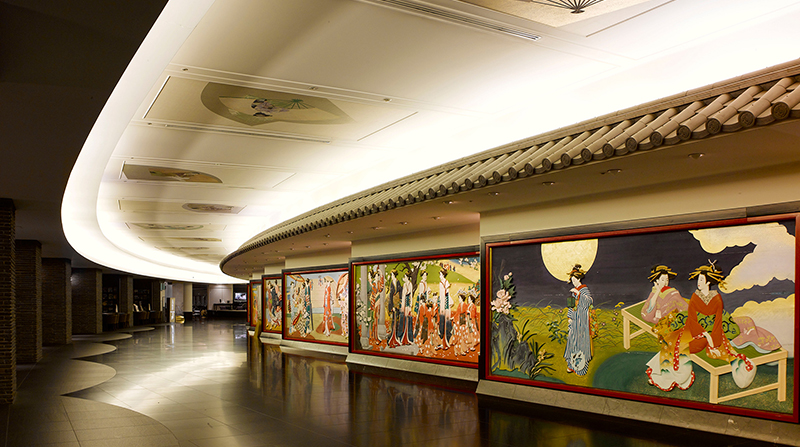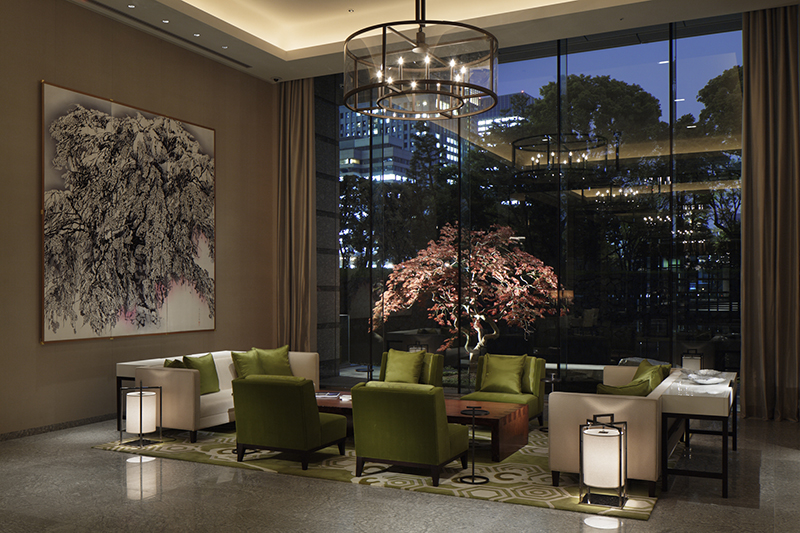
To understand Japanese art is to experience some of the culture for yourself. While traditional mediums and historic pieces are treasured all over the island nation, Tokyo is a special city where modern works are embraced with equal enthusiasm.
Around the capital city, you’ll find thousands of galleries, shops, museums and leisure spaces crammed with canvases, sculptures and installations on which to feast the eyes and revive the soul. Here are but a few art spaces that will take your breath away.
Hotel Gajoen Tokyo
A historic venue dedicated to Japanese art and design, this high-end hotel is like a living museum. Works from the 1920s and ’30s are not just on display, they are part of the property — the elevators are made of Japanese lacquerware inlaid with mother-of-pearl, and hallways are hewn from elaborate wooden carvings and feature simple landscape watercolors that have survived several generations.
Everywhere you go in this 90-year-old hotel, you’re walking through history. The unique relief carvings that line the long corridors, palatial dining areas and event spaces depict life in Japan 100 years ago in vivid color — look closely, each panel tells a story.
Hotel Gajoen even has its own museum. The Hyakudan Kaidan (“100 steps”) is the only remaining part of the original building — a set of wooden stairs leads to tatami rooms decorated by Japan’s most famous artists from the late 1920s. Each room offers a seasonally changing display of artwork and historical artifacts that you won’t want to miss.
Palace Hotel Tokyo
Not many hotels can claim to house a collection of more than 1,000 works of art, but this Forbes Travel Guide Five-Star Marunouchi stay goes a step further —every piece in the property’s extensive gallery was hand-picked or privately commissioned by the Palace Hotel.
Locals and visitors alike flock to the luxurious property to admire the array of artwork and frame-worthy views of the nearby Imperial Palace and its gardens. But what really sets the Palace Hotel’s collection apart from other Tokyo galleries is that it features pieces from both Japanese and international artists.
Among the notable works is Satoshi Uchiumi’s Shikisai no Shita, a seasonally themed burst of color that can be found hanging in the foyer. A spa corridor leading to the treatment rooms has hundreds of objects by origami master Motoi Mitani magically suspended from the ceiling. Even the rooms have beautiful understated items that don’t distract from the spectacular vistas of the extensive green palace gardens next door.
Nezu Museum
Founded by a private collector, this incredible museum houses one of the most compelling collections of pre-modern (before 1940) Japanese art in the city. Spanning mediums from calligraphy and painting to ceramics, armor and bamboo craft, the selection gives a complete look into Tokyo’s creative past.
Every bit as beautiful as the art collection is the museum itself. Designed by renowned Japanese architect Kengo Kuma, the building provides a serene space while the lush Japanese garden surrounding the structure offers an oasis of verdant tranquility in the city. The green space contains a koi pond, stone paths, a wall of bamboo and a traditional Japanese teahouse — an homage to the museum’s founder and his love of the traditional tea ceremony.
https://www.instagram.com/p/BagNcIiDug4/?taken-by=scaithebathhouse
Scai The Bathhouse
A uniquely Japanese move: using a 200-year-old bathhouse in one of Tokyo’s more traditional neighborhoods as an avant-garde art space. Local and international artists work together at Scai to create bold pieces, and not just gallery works but public art as well.
This unique space promotes new, young creatives who have the support of established masters. Tadanori Yokoo, the famous graphic designer, and Anish Kapoor, creator of Chicago’s famous bean-shaped Cloud Gate sculpture, have both had their striking works exhibited at the Scai. Debuting May 29 is the gallery’s latest exhibit, “30 Ways to go to the Moon,” from London-based sculptor Nobuko Tsuchiya.
Although a modern gallery, this historic structure retains its bathhouse aesthetic: it looks exactly as it always did on the outside — the little lockers for your shoes are still at the entrance. Things are just a lot more vivid on the inside. Scai The Bathhouse is not only visited by art lovers, but also by locals looking for inspiration. You’re bound to see people every bit as colorful as the art.

